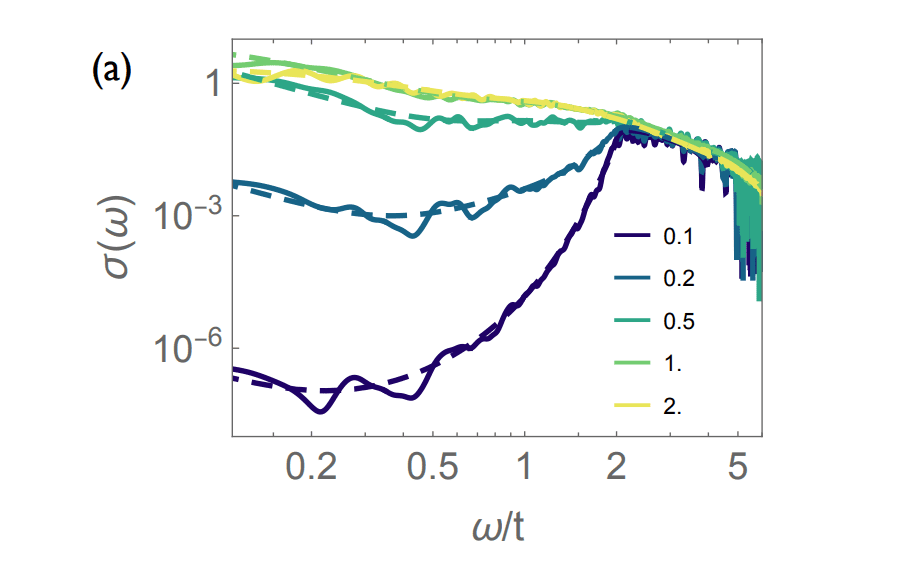The behaviour of electrons moving through materials often dictates their electrical conductivity, and understanding how interactions with the material itself affect this movement remains a key challenge in condensed matter physics. Hadi Rammal from Université Grenoble Alpes, alongside Sergio Ciuchi from the Universitá dell’Aquila and Simone Fratini also from Université Grenoble Alpes, investigate this problem by modelling electrons interacting with microscopic, two-level systems within a material. Their research reveals that these interactions can cause electrons to become temporarily trapped, or localised, significantly increasing electrical resistance, but this effect is strongly dependent on the speed of the interaction. This discovery provides crucial insight into the complex relationship between material properties and charge transport, potentially paving the way for the design of materials with tailored electrical characteristics.
Inelastic scattering and transient localization from coupling to two-level systems Scientists investigate an electron interacting locally with two-level systems as a representative model for charge transport influenced by inelastic scatterers. To determine the significance of quantum effects in both optical and direct current conductivity, researchers solve the model numerically without approximations, employing the finite temperature Lanczos method. The team then compares the results with Dynamical Mean Field Theory. This approach allows for a detailed examination of how interactions with two-level systems affect electron behaviour and conductivity in materials.
Electron Transport with Localized Two-Level Systems
This appendix details the theoretical framework used to calculate transport properties, specifically conductivity, in a model system. The model combines electrons moving within a lattice structure with localized two-level systems, representing impurities with two energy states that interact with the electrons. Calculations are performed using Dynamical Mean-Field Theory, a sophisticated technique that simplifies the complex interactions within the lattice. This allows for a more accurate treatment of electron-electron and electron-two-level system interactions. The final conductivity is calculated using a linear response theory that relates conductivity to the current-current correlation function.
The calculations rely on Green’s functions, which describe how electrons propagate through the system, and derive expressions for the Green’s function, self-energy, and spectral function. The Dynamical Mean-Field Theory approach involves solving a self-consistent equation to determine the self-energy. The two-level systems introduce disorder and scattering, which affect the self-energy and spectral function. Expressions are derived for the optical conductivity and scattering rate, crucial for understanding transport properties. At low temperatures, the conductivity is dominated by the thermal activation of the two-level system impurities, decreasing exponentially with temperature.
This behaviour is characteristic of variable range hopping conductivity, where electrons hop between localized states. The two-level systems act as these localized states, and the hopping probability depends on thermal activation. The results demonstrate that the conductivity is dominated by variable range hopping at low temperatures, highlighting the importance of disorder and localization in determining the transport properties of disordered materials. This model provides a theoretical framework for understanding transport in disordered systems, such as amorphous semiconductors, doped semiconductors, and materials with magnetic impurities.
Transient Localization Enhances Material Resistivity
Scientists investigated charge transport in a model system of electrons interacting with two-level systems, offering insights into the behaviour of materials with complex interactions. The research team employed the finite temperature Lanczos method, a numerical technique allowing for precise calculations without approximations, to explore this interaction and compare the results with Dynamical Mean Field Theory. Results demonstrate that when the energy scale of the two-level systems is slow compared to electron hopping, transient localization of the carriers occurs, enhancing resistivity. This localization is analogous to that previously observed in electron-boson interactions, challenging conventional assumptions in Boltzmann transport theory.
Experiments revealed that this transient localization leads to an increase in resistivity and the appearance of displaced Drude peaks in the frequency response of the carriers. Specifically, the frequency of these peaks directly measures the localization radius of the carriers’ wavefunctions, providing a quantitative measure of the effect. The team mapped the model to a disordered system, demonstrating that at high temperatures, the system behaves similarly to electrons moving on a lattice with random site energies. Further analysis showed that when the energy scale of the two-level systems is fast, the system recovers a more conventional behaviour, with quantum corrections to transport becoming irrelevant.
This indicates that the observed localization is a genuine quantum phenomenon, occurring on timescales shorter than the typical dynamics of the two-level systems. This work extends the understanding of transient localization beyond electron-boson interactions and questions the broad applicability of certain theoretical approaches that neglect quantum interference effects. This research provides a fundamental understanding of charge transport in materials with interacting quantum degrees of freedom, potentially impacting the design of novel electronic devices.
Fluctuations Control Electron Localization and Resistance
This research investigates charge transport in a system where electrons interact with localized two-level systems, a model relevant to understanding materials with complex electronic behaviour. The team achieved a detailed comparison between two advanced numerical methods, the finite temperature Lanczos method and Dynamical Mean Field Theory, to accurately model this interaction without approximations. Results demonstrate that slow fluctuations in the system cause transient localization of electrons, increasing resistance and altering the expected behaviour of electrical current. Conversely, faster fluctuations suppress this localization, restoring more conventional transport properties.
The study clarifies the relationship between electron mobility and scattering within the material, identifying that differences between the two methods arise from how scattering events are treated. Importantly, the research shows that, in this specific model, certain complex corrections to the scattering process are not necessary to accurately describe the system’s behaviour. The team also re-examined the relaxation time approximation, a simpler method for modelling this type of system, and assessed its accuracy against the more precise numerical results. Future work could investigate how these findings apply to more complex materials and explore the potential for controlling charge transport through manipulation of these interactions. This work provides a valuable benchmark for theoretical methods used to study disordered systems and contributes to a deeper understanding of the fundamental principles governing charge transport in materials.

